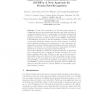Free Online Productivity Tools
i2Speak
i2Symbol
i2OCR
iTex2Img
iWeb2Print
iWeb2Shot
i2Type
iPdf2Split
iPdf2Merge
i2Bopomofo
i2Arabic
i2Style
i2Image
i2PDF
iLatex2Rtf
Sci2ools
137
click to vote
RECOMB
2005
Springer
2005
Springer
Segmentation Conditional Random Fields (SCRFs): A New Approach for Protein Fold Recognition
Abstract. Protein fold recognition is an important step towards understanding protein three-dimensional structures and their functions. A conditional graphical model, i.e. segmentation conditional random fields (SCRFs), is proposed to solve the problem. In contrast to traditional graphical models such as hidden markov model (HMM), SCRFs follow a discriminative approach. It has the flexibility to include overlapping or long-range interaction features over the whole sequence, as well as global optimally solutions for the parameters. On the other hand, the segmentation setting in SCRFs makes its graphical structures intuitively similar to the protein 3-D structures and more importantly, provides a framework to model the long-range interactions directly. Our model is applied to predict the parallel -helix fold, an important fold in bacterial infection of plants and binding of antigens. The crossfamily validation shows that SCRFs not only can score all known helices higher than non -helices...
Computational Biology | Conditional Random Fields | General Motif Detection | Global Optimally Solutions | RECOMB 2005 |
Related Content
| Added | 03 Dec 2009 |
| Updated | 03 Dec 2009 |
| Type | Conference |
| Year | 2005 |
| Where | RECOMB |
| Authors | Yan Liu, Jaime G. Carbonell, Peter Weigele, Vanathi Gopalakrishnan |
Comments (0)

